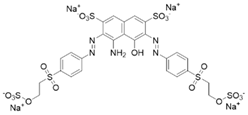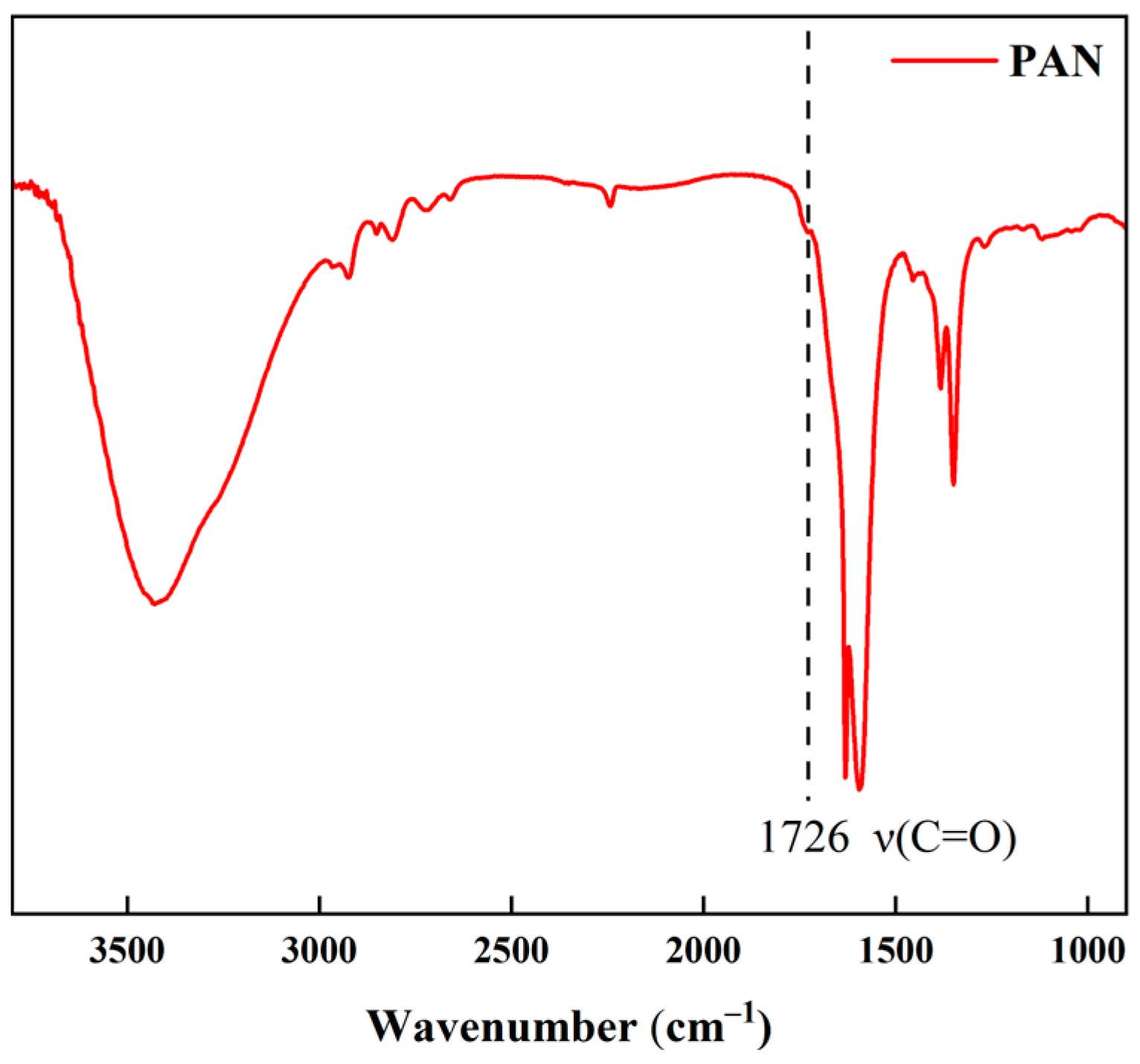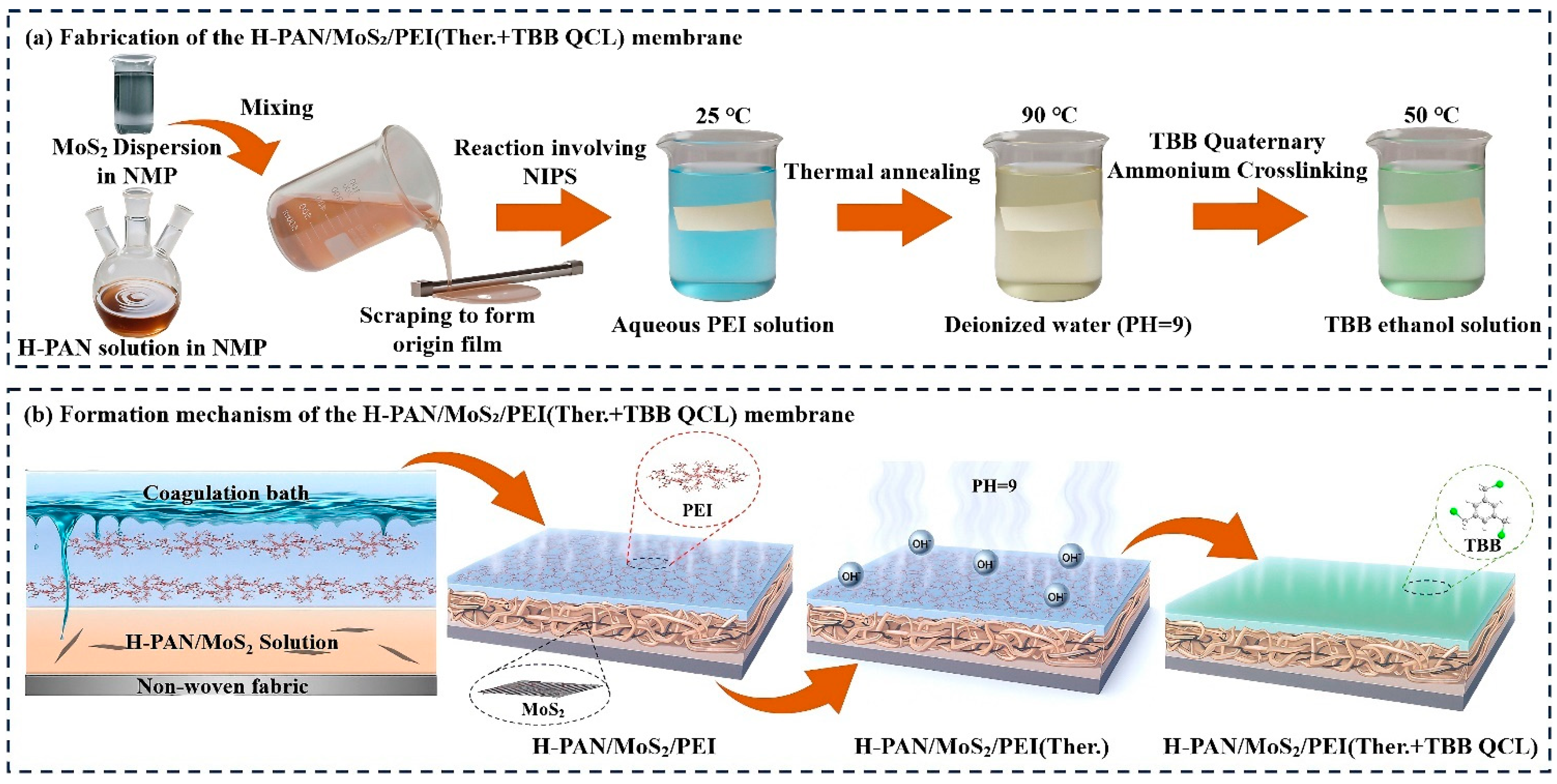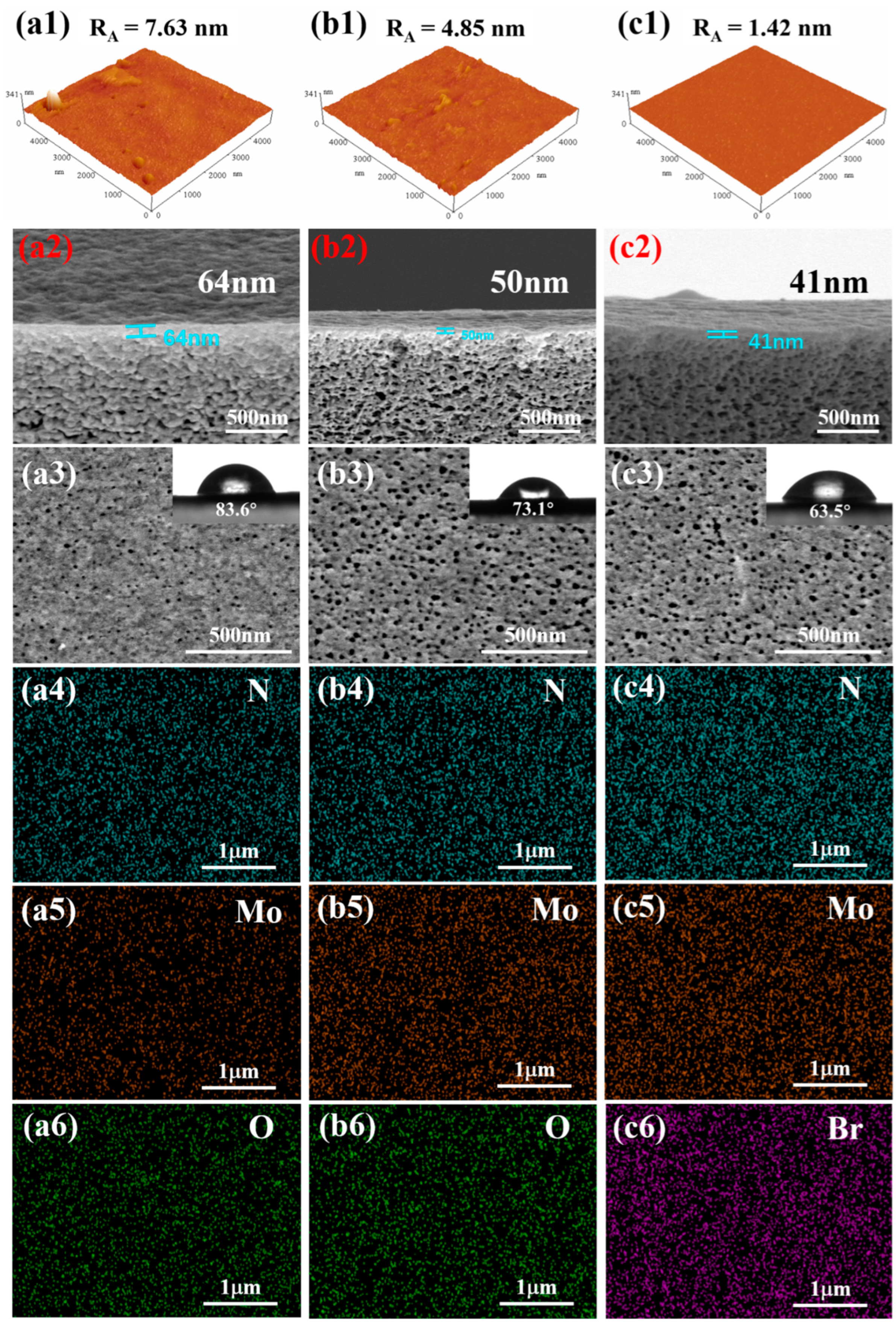Double-Crosslinked H-PAN/MoS2/PEI Composite Nanofiltration Membrane for Ethanol Systems: Fabrication and Dye Separation Performance
Abstract
1. Introduction
2. Materials and Methods
2.1. Materials
2.2. Preparation of the H-PAN/MoS2/PEI (Ther.+TBB QCL) Membrane
2.3. Membrane Characterization
2.4. Organic Solvent Nanofiltration Performance Testing
2.5. Membrane Antifouling Performance Evaluation
2.6. Solvent Stability Evaluation
3. Results
4. Conclusions
Author Contributions
Funding
Institutional Review Board Statement
Informed Consent Statement
Data Availability Statement
Conflicts of Interest
Appendix A
| Name | MW(Da)/Charge | Chemical Structure | 3D Structure |
|---|---|---|---|
| Sunset Yellow (SY) | 452/2 |  |  |
| Congo Red (CR) | 696/2 |  |  |
| Evans Blue (EB) | 961/4 |  |  |
| Reactive black (RB) | 992/4 |  |  |
Appendix B

References
- White, L.S. Transport properties of a polyimide solvent resistant nanofiltration membrane. J. Membr. Sci. 2002, 205, 191–202. [Google Scholar] [CrossRef]
- White, L.S.; Wildemuth, C.R. Aromatics Enrichment in Refinery Streams Using Hyperfiltration. Ind. Eng. Chem. Res. 2006, 45, 9136–9143. [Google Scholar] [CrossRef]
- Kim, J.F.; Szekely, G.; Schaepertoens, M.; Valtcheva, I.B.; Jimenez-Solomon, M.F.; Livingston, A.G. In Situ Solvent Recovery by Organic Solvent Nanofiltration. ACS Sustain. Chem. Eng. 2014, 2, 2371–2379. [Google Scholar] [CrossRef]
- Mertens, M.; Van Goethem, C.; Thijs, M.; Koeckelberghs, G.; Vankelecom, I.F.J. Crosslinked PVDF-membranes for solvent resistant nanofiltration. J. Membr. Sci. 2018, 566, 223–230. [Google Scholar] [CrossRef]
- Marchetti, P.; Butté, A.; Livingston, A.G. NF in organic solvent/water mixtures: Role of preferential solvation. J. Membr. Sci. 2013, 444, 101–115. [Google Scholar] [CrossRef]
- Loh, X.X.; Sairam, M.; Bismarck, A.; Steinke, J.H.G.; Livingston, A.G.; Li, K. Crosslinked integrally skinned asymmetric polyaniline membranes for use in organic solvents. J. Membr. Sci. 2009, 326, 635–642. [Google Scholar] [CrossRef]
- Cook, M.; Gaffney, P.R.J.; Peeva, L.G.; Livingston, A.G. Roll-to-roll dip coating of three different PIMs for Organic Solvent Nanofiltration. J. Membr. Sci. 2018, 558, 52–63. [Google Scholar] [CrossRef]
- Marchetti, P.; Livingston, A.G. Predictive membrane transport models for Organic Solvent Nanofiltration: How complex do we need to be? J. Membr. Sci. 2015, 476, 530–553. [Google Scholar] [CrossRef]
- Francis, V.N.; Chong, J.Y.; Yang, G.; Che, L.; Wang, R. Robust polyamide-PTFE hollow fibre membranes for harsh organic solvent nanofiltration. Chem. Eng. J. 2023, 452, 139333. [Google Scholar] [CrossRef]
- Xu, Y.; You, F.; Sun, H.; Shao, L. Realizing Mussel-Inspired Polydopamine Selective Layer with Strong Solvent Resistance in Nanofiltration toward Sustainable Reclamation. ACS Sustain. Chem. Eng. 2017, 5, 5520–5528. [Google Scholar] [CrossRef]
- Xu, Y.C.; Cheng, X.Q.; Long, J.; Shao, L. A novel monoamine modification strategy toward high-performance organic solvent nanofiltration (OSN) membrane for sustainable molecular separations. J. Membr. Sci. 2016, 497, 77–89. [Google Scholar] [CrossRef]
- Oxley, A.; Livingston, A.G. Anti-fouling membranes for organic solvent nanofiltration (OSN) and organic solvent ultrafiltration (OSU): Graft modified polybenzimidazole (PBI). J. Membr. Sci. 2022, 662, 120977. [Google Scholar] [CrossRef]
- Lim, S.K.; Goh, K.; Bae, T.-H.; Wang, R. Polymer-based membranes for solvent-resistant nanofiltration: A review. Chin. J. Chem. Eng. 2017, 25, 1653–1675. [Google Scholar] [CrossRef]
- Vanherck, K.; Koeckelberghs, G.; Vankelecom, I.F.J. Crosslinking polyimides for membrane applications: A review. Prog. Polym. Sci. 2013, 38, 874–896. [Google Scholar] [CrossRef]
- Sairam, M.; Loh, X.X.; Li, K.; Bismarck, A.; Steinke, J.H.G.; Livingston, A.G. Nanoporous asymmetric polyaniline films for filtration of organic solvents. J. Membr. Sci. 2009, 330, 166–174. [Google Scholar] [CrossRef]
- Sairam, M.; Loh, X.X.; Bhole, Y.; Sereewatthanawut, I.; Li, K.; Bismarck, A.; Steinke, J.H.G.; Livingston, A.G. Spiral-wound polyaniline membrane modules for organic solvent nanofiltration (OSN). J. Membr. Sci. 2010, 349, 123–129. [Google Scholar] [CrossRef]
- Zhang, Y.; Wang, H.; Li, L.; Zhang, X.; Dong, X.; Wang, X.; Pan, Y.; Wang, T. Effects of polyacrylonitrile carboxylation on pore structure and performance of thermally crosslinked organic solvent nanofiltration membrane. Chem. Eng. Sci. 2024, 287, 119731. [Google Scholar] [CrossRef]
- Chisca, S.; Musteata, V.-E.; Zhang, W.; Vasylevskyi, S.; Falca, G.; Abou-Hamad, E.; Emwas, A.-H.; Altunkaya, M.; Nunes, S.P. Polytriazole membranes with ultrathin tunable selective layer for crude oil fractionation. Science 2022, 376, 1105–1110. [Google Scholar] [CrossRef] [PubMed]
- Feng, W.; Li, J.; Fang, C.; Zhang, L.; Zhu, L. Controllable thermal annealing of polyimide membranes for highly-precise organic solvent nanofiltration. J. Membr. Sci. 2022, 643, 120013. [Google Scholar] [CrossRef]
- Bhuwania, N.; Labreche, Y.; Achoundong, C.S.K.; Baltazar, J.; Burgess, S.K.; Karwa, S.; Xu, L.; Henderson, C.L.; Williams, P.J.; Koros, W.J. Engineering substructure morphology of asymmetric carbon molecular sieve hollow fiber membranes. Carbon 2014, 76, 417–434. [Google Scholar] [CrossRef]
- Zhang, C.; Zhang, K.; Cao, Y.; Koros, W.J. Composite Carbon Molecular Sieve Hollow Fiber Membranes: Resisting Support Densification via Silica Particle Stabilization. Ind. Eng. Chem. Res. 2018, 57, 16051–16058. [Google Scholar] [CrossRef]
- Koh, D.-Y.; McCool, B.A.; Deckman, H.W.; Lively, R.P. Reverse osmosis molecular differentiation of organic liquids using carbon molecular sieve membranes. Science 2016, 353, 804–807. [Google Scholar] [CrossRef]
- Han, Y.; Jiang, Z.; Gao, C. High-flux graphene oxide nanofiltration membrane intercalated by carbon nanotubes. ACS Appl. Mater. Interfaces 2015, 7, 8147–8155. [Google Scholar] [CrossRef]
- Huang, H.; Song, Z.; Wei, N.; Shi, L.; Mao, Y.; Ying, Y.; Sun, L.; Xu, Z.; Peng, X. Ultrafast viscous water flow through nanostrand-channelled graphene oxide membranes. Nat. Commun. 2013, 4, 2979. [Google Scholar] [CrossRef] [PubMed]
- Huang, I.; Ding, L.; Caro, J.; Wang, H. MXene-based membranes for drinking water production. Angew. Chem. Int. Ed. 2023, 62, e202311338. [Google Scholar] [CrossRef] [PubMed]
- Karahan, H.E.; Goh, K.; Zhang, C.; Yang, E.; Yildirim, C.; Chuah, C.Y.; Ahunbay, M.G.; Lee, J.; Tantekin-Ersolmaz, S.B.; Chen, Y.; et al. MXene materials for designing advanced separation membranes. Adv. Mater. 2020, 32, 1906697. [Google Scholar] [CrossRef] [PubMed]
- Xue, Q.; Lim, Y.J.; Zhang, K. Engineering multi-channel water transport in surface-porous MXene nanosheets for high-performance thin-film nanocomposite membranes. J. Membr. Sci. 2025, 728, 124151. [Google Scholar] [CrossRef]
- Wang, Z.-Y.; Feng, R.; Wang, W.-J.; Sun, Y.-X.; Tao, S.-N.; Wang, Y.-M.; Chen, Y.-F.; Fu, Z.-J.; Cao, X.-L.; Sun, S.-P.; et al. Robust braid reinforced hollow fiber membranes for organic solvent nanofiltration (OSN). Adv. Membr. 2021, 1, 100007. [Google Scholar] [CrossRef]
- Wang, L.; Zhang, M.; Shu, Y.; Han, Q.; Long, L.; Chen, B.; Wang, M.; Li, L.; Cao, S.; Yang, Z.; et al. Covalently modified MoS2 for the fabrication of interlayered thin film composite membranes with excellent structural stability against swelling and drying in organic solvent nanofiltration. J. Membr. Sci. 2024, 707, 122985. [Google Scholar] [CrossRef]
- Liu, J.; Zhao, Z.; Li, L.; Wu, Y.; He, H. Molecular simulation study of 2D MXene membranes for organic solvent nanofiltration. J. Membr. Sci. 2023, 677, 121623. [Google Scholar] [CrossRef]
- Wu, M.; Fu, X.; Li, J.; Zhao, W.; Li, X. SWCNTs-channeled MOF nanosheet membrane for high-efficient organic solvent nanofiltration. Sep. Purif. Technol. 2024, 338, 126328. [Google Scholar] [CrossRef]
- Kandambeth, S.; Dey, K.; Banerjee, R. Covalent organic frameworks for membrane separation. Chem. Soc. Rev. 2019, 48, 4536–4546. [Google Scholar] [CrossRef]
- Wang, Y.; Li, Z.; Wang, Y.; Zhou, Y.; Zhang, Y.; Wang, H. Two-dimensional covalent organic framework membranes for liquid molecular separation. Sci. China Mater. 2021, 64, 2617–2628. [Google Scholar]
- Bertolazzi, S.; Brivio, J.; Kis, A. Stretching and Breaking of Ultrathin MoS2. ACS Nano 2011, 5, 9703–9709. [Google Scholar] [CrossRef] [PubMed]
- Hirunpinyopas, W.; Prestat, E.; Worrall, S.D.; Haigh, S.J.; Dryfe, R.A.W.; Bissett, M.A. Desalination and Nanofiltration through Functionalized Laminar MoS2 Membranes. ACS Nano 2017, 11, 11082–11090. [Google Scholar] [CrossRef]
- Du, J.R.; Du, F.; Yang, K.; Zheng, J.; Ma, K.; Du, C.; Yang, H. Screening of high-efficiency crosslinking agents for poly(N,N-dimethylaminoethyl methacrylate) and performance of its nanofiltration membranes. J. Membr. Sci. 2023, 682, 121868. [Google Scholar] [CrossRef]
- Naderi, A.; Asadi Tashvigh, A.; Chung, T.-S. H2/CO2 separation enhancement via chemical modification of polybenzimidazole nanostructure. J. Membr. Sci. 2019, 572, 343–349. [Google Scholar] [CrossRef]
- Liu, C.; Zhu, L.; Zhang, Y.; Hu, W.; Shen, Y.; Jin, H.; Wang, H.; Niu, W. Facile fabrication of high-performance membrane with 2D GO nanosheet in membrane skin by PIC-assisted NIPS method for dye/salt separation. J. Membr. Sci. 2025, 733, 124339. [Google Scholar] [CrossRef]
- Guo, H.; Ma, Y.; Qin, Z.; Gu, Z.; Cui, S.; Zhang, G. One-Step Transformation from Hierarchical-Structured Superhydrophilic NF Membrane into Superhydrophobic OSN Membrane with Improved Antifouling Effect. ACS Appl. Mater. Interfaces 2016, 8, 23379–23388. [Google Scholar] [CrossRef] [PubMed]
- Zhao, Z.; Di, N.; Zha, Z.; Wang, J.; Wang, Z.; Zhao, S. Positively Charged Polyamine Nanofiltration Membrane for Precise Ion–Ion Separation. ACS Appl. Mater. Interfaces 2023, 15, 48695–48704. [Google Scholar] [CrossRef]
- Qiu, F.; Sun, Y.; Zhang, Y.; Liu, H.; Shao, L.; Huang, Q. Electrospun PTFE nanofibrous composite membranes featuring a fiber network structure for organic solvent nanofiltration (OSN). Sep. Purif. Technol. 2023, 330, 125416. [Google Scholar] [CrossRef]
- Kim, S.H.; Khan, M.A.; Im, K.S.; Kang, P.; Nam, S.Y. Enhanced Organic Solvent Nanofiltration Membranes with Double Permeance via Laser-Induced Graphitization of Polybenzimidazole. Adv. Mater. Interfaces 2024, 11, 2400490. [Google Scholar] [CrossRef]
- Abdul, W.; Umair, B.; Isam, H.A. Fabrication of molecularly porous hyper-cross-linked thin film composite nanofiltration membrane using cyclic amine and linear cross-linker for highly selective organic solvent nanofiltration. Colloid Interface Sci. Commun. 2021, 45, 100530. [Google Scholar]
- Yan, X.; Wan, H.; Xing, X.; Yang, J.; Yan, G.; Zhang, G. High permeance nanofiltration membrane for harsh organic solvent based on spiral-ring polyesters. J. Membr. Sci. 2023, 687, 122035. [Google Scholar] [CrossRef]
- Lin, S.; Semiao, A.C.; Zhang, Y.; Lu, S.; Lau, C.H. Interfacial polymerization using biobased solvents and their application as desalination and organic solvent nanofiltration membranes. J. Membr. Sci. 2023, 692, 122281. [Google Scholar] [CrossRef]
- Li, H.; Li, X.; Ouyang, G.; Huang, L.; Li, L.; Li, W.; Huang, W.; Li, D. Ultrathin organic solvent nanofiltration membrane with polydopamine-HKUST-1 interlayer for organic solvent separation. J. Environ. Sci. 2023, 141, 182–193. [Google Scholar] [CrossRef]
- Yao, A.; Hua, D.; Hong, Y.; Pan, J.; Cheng, X.; Tan, K.B.; Zhan, G. Using Cu-TCPP Nanosheets as Interlayers for High-Performance Organic Solvent Nanofiltration Membranes. ACS Appl. Nano Mater. 2022, 5, 18718–18729. [Google Scholar] [CrossRef]
- Davood Abadi Farahani, M.H.; Hua, D.; Chung, T.-S. Cross-linked mixed matrix membranes consisting of carboxyl-functionalized multi-walled carbon nanotubes and P84 polyimide for organic solvent nanofiltration (OSN). Sep. Purif. Technol. 2017, 186, 243–254. [Google Scholar] [CrossRef]






| Membrane | Ethanol Permeability (L·m−2·h−1·bar−1) | The Rejection of Dye (%) | Operating Condition | Reference |
|---|---|---|---|---|
| PDA-PA/PTFE composite nanofiltration membrane (MI-3) | 5.95 | CR: 86.6 | cross-flow (2 bar) | [41] |
| PBI-LIG (1,1) membrane | 12.14 | CR: 94 | cross-flow (5 bar) | [42] |
| Thin-film composite molecularly porous hyper-crosslinked membrane (TFC-MPCM) | 1.69 | CR: 94 | cross-flow (4 bar) | [43] |
| SBI-OPASS TFC membrane (Mem-NaOH-4) | 21.5 | CR: 94.7 | cross-flow (1 bar) | [44] |
| PIP-TMC polyamide thin-film composite membrane fabricated with 2-methyltetrahydrofuran (2-MeTHF) as organic solvent | 9.87 | RB: 97.1 | cross-flow (3 bar) | [45] |
| PA/PDA-HKUST-10.6/PEI membrane | 31.2 | CR: 92.8 | cross-flow (6 bar) | [46] |
| PVDF/t-Cu-TCPP-(3)/PA membrane | 2.75 | CR: 95 | cross-flow (7 bar) | [47] |
| Annealed crosslinked mixed matrix membrane comprising 0.05 wt.% MWCNT-COOH in P84 polyimide (M3–30) | 9.6 | RB: 85 | cross-flow (5 bar) | [48] |
| H-PAN/MoS2/PEI (Ther.+TBB QCL) membrane | 23.6 | CR: 97 | cross-flow (4 bar) | This work |
Disclaimer/Publisher’s Note: The statements, opinions and data contained in all publications are solely those of the individual author(s) and contributor(s) and not of MDPI and/or the editor(s). MDPI and/or the editor(s) disclaim responsibility for any injury to people or property resulting from any ideas, methods, instructions or products referred to in the content. |
© 2025 by the authors. Licensee MDPI, Basel, Switzerland. This article is an open access article distributed under the terms and conditions of the Creative Commons Attribution (CC BY) license (https://creativecommons.org/licenses/by/4.0/).
Share and Cite
Zhang, Y.; Liu, C.; Zhu, L.; Zhou, X.; Wang, M.; Shen, Y. Double-Crosslinked H-PAN/MoS2/PEI Composite Nanofiltration Membrane for Ethanol Systems: Fabrication and Dye Separation Performance. Membranes 2025, 15, 286. https://doi.org/10.3390/membranes15100286
Zhang Y, Liu C, Zhu L, Zhou X, Wang M, Shen Y. Double-Crosslinked H-PAN/MoS2/PEI Composite Nanofiltration Membrane for Ethanol Systems: Fabrication and Dye Separation Performance. Membranes. 2025; 15(10):286. https://doi.org/10.3390/membranes15100286
Chicago/Turabian StyleZhang, Yixin, Chunli Liu, Lei Zhu, Xin Zhou, Miaona Wang, and Yongqian Shen. 2025. "Double-Crosslinked H-PAN/MoS2/PEI Composite Nanofiltration Membrane for Ethanol Systems: Fabrication and Dye Separation Performance" Membranes 15, no. 10: 286. https://doi.org/10.3390/membranes15100286
APA StyleZhang, Y., Liu, C., Zhu, L., Zhou, X., Wang, M., & Shen, Y. (2025). Double-Crosslinked H-PAN/MoS2/PEI Composite Nanofiltration Membrane for Ethanol Systems: Fabrication and Dye Separation Performance. Membranes, 15(10), 286. https://doi.org/10.3390/membranes15100286






